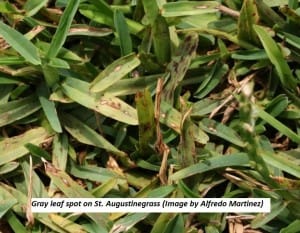Alfredo Martinez, Extension Plant Pathologist
Time to scout for gray leaf spot
Gray leaf spot is a fungus disease that affects St. Augustinegrass, perennial ryegrass and tall fescue in Georgia. Hot humid summer weather and high nitrogen levels can make turf susceptible to this disease. The fungus causing the disease is Pyricularia grisea.
 Symptoms: The symptoms of gray leaf spot vary depending on the grass cultivar. On St. Augustinegrass, gray leaf spot first appears as small, brown spots on the leaves and stems. The spots quickly enlarge to approximately ¼ inch in length and become bluish-gray and oval or elongated in shape. The mature lesions are tan to gray and have depressed centers with irregular margins that are purple to brown (see image). A yellow border on the lesions can also occur. In cool-season turfgrass, the symptoms are similar to those of melting out.
Symptoms: The symptoms of gray leaf spot vary depending on the grass cultivar. On St. Augustinegrass, gray leaf spot first appears as small, brown spots on the leaves and stems. The spots quickly enlarge to approximately ¼ inch in length and become bluish-gray and oval or elongated in shape. The mature lesions are tan to gray and have depressed centers with irregular margins that are purple to brown (see image). A yellow border on the lesions can also occur. In cool-season turfgrass, the symptoms are similar to those of melting out.
Conditions Favoring Disease: Gray leaf spot is favored by daytime temperatures between 80°F to 90°F and night temperatures above 65°F. It is also found in areas with high nitrogen levels and that are stressed by various factors, including drought and soil compaction. This disease is most severe during extended hot, rainy and humid periods.
Disease Management Tips: Avoid medium to high nitrogen levels during mid-summer. Irrigate turf deeply and as infrequently as possible to avoid water stress. Allow water to remain on leaves for only a short period of time. Reduce thatch. When possible, plant turfgrass that is resistant to gray leaf spot. Avoid using herbicides or plant growth regulators when the disease is active.
Fungicides are available to control the disease. Consult the current Georgia Pest Management Handbook .
For more information or photos of gray leaf spot – Turfgrass Diseases in Georgia – gray leaf spot
Rust on zoysiagrass
Several zoysiagrass samples infected with rust were recently submitted to our plant disease clinic. Rust is a disease caused by fungi belonging to the genus Puccinia and/or Uromyces. In Georgia, we usually find it more prevalent in ryegrass, certain types of Festuca sp (tall fescue), and zoysiagrass.
The rust pathogen survives as mycelium and spores (urediniospores and teliospores) in thatch, infected plants and soil. Rust spores can also be spread and disseminated long distances by air currents and locally by people, animals and equipment. Weedy grasses may be a source of some rust fungi. When there is disease-conducive weather, spores or mycelium germinates and new foliar infections are initiated.
There is a range of temperatures where rust can grow depending on the rust type and turfgrass species interaction. In Georgia, rust infections are common throughout the summer. Leaf wetness, moisture on the turfgrass canopy, and heavy dews favors rust development. Rust diseases initially cause light-yellow flecks on the leaf blades and sheaths. The flecks enlarge, elongate, and turn yellow in color. The infected areas rise above the leaf epidermis and then rupture, releasing the yellowish-orange to reddish-brown urediniospores (see images). The leaf blade turns yellow starting at the tip and progressing to the base. Overall, rust as a whole causes relatively minor turfgrass stand losses. However the disease has the potential to cause severe outbreaks in stressed, weakened turfgrass areas.
Control: Rust infections occur on slow-growing turfgrass particularly those areas with low nitrogen levels, imbalanced soil fertility, plant water stress, and shaded-low lighted areas and/or soil compaction. Therefore rust severity can be greatly reduced by maintaining a healthy, vigorous turf stand.
Maintain recommended soil fertility and soil pH levels. Following nitrogen fertility recommendations is a critical factor in controlling rust in warm season grasses. Proper irrigation practices such as avoiding irrigation during early evening, will limit the spread of the disease by diminishing the chance of extended dew periods. Proper mowing heights and removal of clippings can help to reduce inoculums levels. Improve air circulation and light penetration on shaded, closed areas.
Fungicides are rarely required for rust control in turfgrass. However, in some cases, fungicides are needed. There are a variety of fungicides that are effective against turfgrass rust diseases. Demethylation inhibitors (DMI’s) fungicides, the QoI (strobilurins), or the benzimidazole fungicides are effective against rust. Consult the current Georgia Pest Management Handbook .
More information on turfgrass rust diseases:
Article by Dr. Martinez on Rust in Lawn & Landscape magazine
